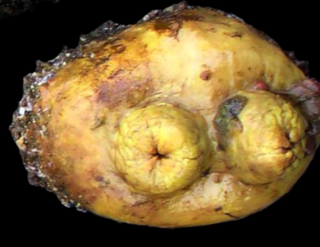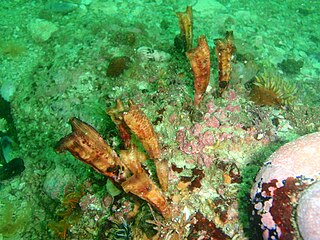
A tunicate is an exclusively marine invertebrate animal, a member of the subphylum Tunicata. This grouping is part of the Chordata, a phylum which includes all animals with dorsal nerve cords and notochords. The subphylum was at one time called Urochordata, and the term urochordates is still sometimes used for these animals. They are the only chordates that have lost their myomeric segmentation, with the possible exception of the seriation of the gill slits. However, doliolids still display segmentation of the muscle bands.

Ascidiacea, commonly known as the ascidians or sea squirts, is a paraphyletic class in the subphylum Tunicata of sac-like marine invertebrate filter feeders. Ascidians are characterized by a tough outer "tunic" made of a polysaccharide.

Pyura is a large genus of sessile ascidians that live in coastal waters at depths of up to 80 m (260 feet). Like all ascidians, Pyura are filter feeders. A few species, including Pyura chilensis are commercially fished.
In Australia, a cunjevoi may mean:

The Southwest Shelf Transition, also known as the Houtman marine ecoregion, is a biogeographic region of Australia's continental shelf and coastal waters. It includes the subtropical coastal waters of Southwest Australia.

Pyura praeputialis is an intertidal and shallow water species of tunicate. It is one of three species of "cunjevoi" in Australasia. It is the first reported species of marine organism to create a "foam-nest" for its larvae.

Pycnoclavella diminuta, known as the white-spotted sea squirt, white-spot ascidian, and white-spotted ascidian, is a species of tunicate, in the genus Pycnoclavella. Like all ascidians, these sessile animals are filter feeders.

Ecteinascidia turbinata, commonly known as the mangrove tunicate, is a species of tunicate in the family Perophoridae. It was described to science in 1880 by William Abbott Herdman. The cancer drug trabectedin can be isolated from this species.

Polycarpa aurata, also known as the ox heart ascidian, the gold-mouth sea squirt or the ink-spot sea squirt, is a species of tunicate in the family Styelidae.

Didemnum molle is a species of colonial tunicate in the family Didemnidae. It is commonly known as the tall urn ascidian, the green barrel sea squirt or the green reef sea-squirt. It is native to the Red Sea and the tropical waters of the Indo-Pacific region.

Pontohedyle is a genus of sea slugs, acochlidians, shell-less marine gastropod mollusks in the family Parhedylidae. Sea slugs in this genus are highly simplified and uniform.

Pyura dalbyi, the yellow cunjevoi, is a species of tunicate

Pyura doppelgangera, the doppelganger cunjevoi, is a tunicate that lives in coastal waters of Australasia attached to rocks or artificial structures.

Pyura herdmani, one of two southern African species of "red bait", is a sessile ascidian, or sea squirt, that lives in coastal waters attached to rocks or artificial structures. Sea squirts are named for their habit of squirting a stream of water from their exhalant siphons when touched at low tide.

Styela angularis is a solitary, hermaphroditic ascidian tunicate that is found along the coast of Southern Africa from Lüderitz Bay in Namibia to the Eastern Cape.

Pyura haustor is a species of sessile ascidian, or sea squirt, that lives in coastal waters in the north-eastern Pacific Ocean, attached to rocks or artificial structures. Common names for this species include the wrinkled seapump, the wrinkled sea squirt and the warty tunicate.

Beryl Iris Brewin was a New Zealand marine zoologist, specialising in ascidians.
The Trafalgar Marine Protected Area is an inshore conservation region in the territorial waters of South Africa in kwaZulu-Natal, between Port Edward and Margate.


















